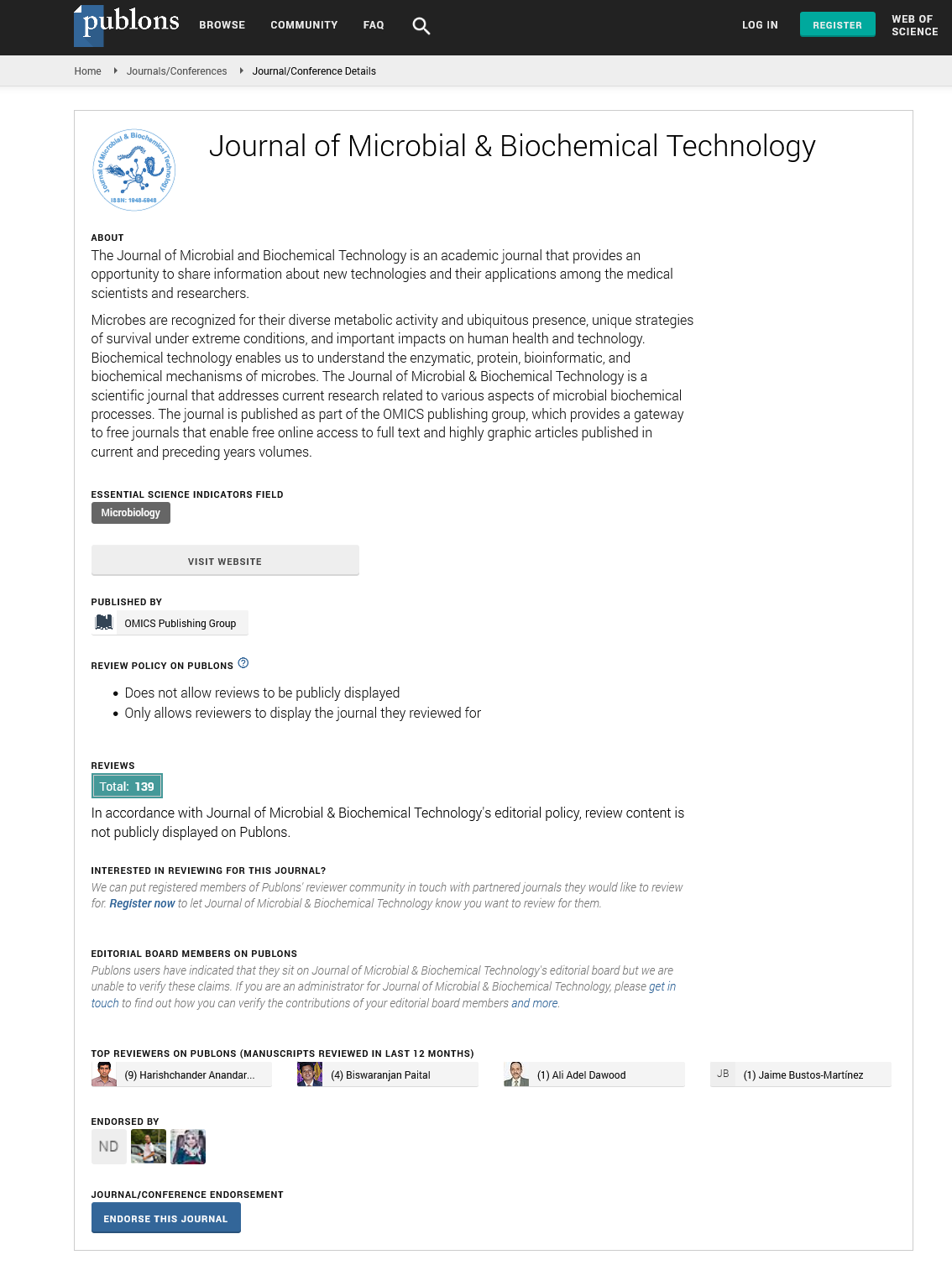Indexed In
- Academic Journals Database
- Genamics JournalSeek
- Academic Keys
- JournalTOCs
- China National Knowledge Infrastructure (CNKI)
- Scimago
- Access to Global Online Research in Agriculture (AGORA)
- Electronic Journals Library
- RefSeek
- Directory of Research Journal Indexing (DRJI)
- Hamdard University
- EBSCO A-Z
- OCLC- WorldCat
- SWB online catalog
- Virtual Library of Biology (vifabio)
- Publons
- MIAR
- University Grants Commission
- Geneva Foundation for Medical Education and Research
- Euro Pub
- Google Scholar
Useful Links
Share This Page
Journal Flyer

Open Access Journals
- Agri and Aquaculture
- Biochemistry
- Bioinformatics & Systems Biology
- Business & Management
- Chemistry
- Clinical Sciences
- Engineering
- Food & Nutrition
- General Science
- Genetics & Molecular Biology
- Immunology & Microbiology
- Medical Sciences
- Neuroscience & Psychology
- Nursing & Health Care
- Pharmaceutical Sciences
Commentary - (2024) Volume 2, Issue 1
Microbial Biosensors: Applications in Environmental Monitoring and Healthcare
Michael Moraskie*Received: 30-Oct-2023, Manuscript No. JMBT-23-23650; Editor assigned: 02-Nov-2023, Pre QC No. JMBT-23-23650 (PQ); Reviewed: 16-Nov-2023, QC No. JMBT-23-23650; Revised: 16-Sep-2024, Manuscript No. JMBT-23-23650 (R); Published: 23-Sep-2024, DOI: 10.35248/1948-5948.24.16.624
Description
Microbial biosensors have emerged as powerful tools with versatile applications in environmental monitoring and healthcare. These ingenious devices harness the unique properties of microorganisms to detect and quantify various analytes, providing rapid and cost-effective solutions for a range of challenges. In this article, we delve into the fascinating world of microbial biosensors, exploring their principles, applications, and the pivotal role they play in safeguarding our environment and improving healthcare.
The fundamentals of microbial biosensors
Microbial biosensors are analytical devices that employ living microorganisms, such as bacteria, yeast, or algae, to detect specific compounds in their environment. These organisms are genetically engineered or naturally selected to respond to target analytes, producing a measurable signal as a result of their interaction. The fundamental components of a microbial biosensor typically include the microbial cell or a part of it (e.g., enzymes), a transducer that converts the biological response into an electrical or optical signal, and a data acquisition system for signal processing and analysis.
The key to the effectiveness of microbial biosensors lies in the specificity of the chosen microorganism or enzyme. By modifying their genetic makeup or tailoring their environment, scientists can design biosensors to detect a wide array of substances, from heavy metals and organic pollutants in water to glucose levels in blood.
Environmental monitoring applications
Environmental monitoring is a critical application domain for microbial biosensors. With growing concerns about pollution, climate change, and the degradation of ecosystems, there is an increasing demand for efficient and reliable tools to assess and mitigate these threats.
Water quality assessment: Microbial biosensors are invaluable in assessing water quality. By using specific microorganisms that react to contaminants, such as heavy metals, organic pollutants, or pathogens, these biosensors can provide real-time data on water quality. This is vital for safeguarding both aquatic ecosystems and human health.
Air quality monitoring: Microbial biosensors can also be employed to assess air quality. For example, they can be designed to detect harmful gases like sulfur dioxide or nitrogen dioxide, aiding in the identification of pollution sources and the implementation of countermeasures.
Soil analysis: Monitoring soil quality and contamination is crucial for sustainable agriculture and the protection of ecosystems. Microbial biosensors, with tailored microorganisms, can detect soil pollutants, nutrients, and other critical parameters.
Bioremediation: In addition to monitoring, microbial biosensors play a role in bioremediation efforts. By engineering microorganisms to break down or sequester pollutants, these biosensors contribute to the cleanup of contaminated sites, offering a greener and more sustainable approach to environmental restoration.
Healthcare applications
In healthcare, microbial biosensors have found their niche in diagnostics, research, and treatment monitoring. These applications are marked by their accuracy, speed, and potential for point-of-care testing.
Infectious disease detection: Microbial biosensors are used to detect pathogens like bacteria and viruses. By harnessing the specific interactions between these microorganisms and the pathogens, biosensors can rapidly identify infections, facilitating timely and targeted treatment.
Glucose monitoring: For individuals with diabetes, continuous glucose monitoring is essential. Microbial biosensors that rely on engineered yeast or bacteria can detect glucose levels and provide real-time data, reducing the need for frequent blood tests.
Drug screening: In drug development, microbial biosensors are crucial for screening potential compounds. These biosensors can indicate the efficacy of a drug candidate by measuring its impact on a specific biological pathway.
Cancer biomarkers: The early detection of cancer biomarkers is crucial for timely diagnosis and intervention. Microbial biosensors can be tailored to recognize specific biomarkers, such as proteins or nucleic acids associated with various cancers.
Challenges and future directions
While microbial biosensors have shown immense promise, there are still challenges to overcome. Maintaining the viability and stability of the living organisms within the biosensors, optimizing sensor response times, and ensuring specificity and selectivity are ongoing areas of research and development.
Citation: Moraskie M (2024) Microbial Biosensors: Applications in Environmental Monitoring and Healthcare. J Microb Biochem Technol. 16:624.
Copyright: �?�© 2024 Moraskie M. This is an open access article distributed under the terms of the Creative Commons Attribution License, which permits unrestricted use, distribution, and reproduction in any medium, provided the original author and source are credited.

